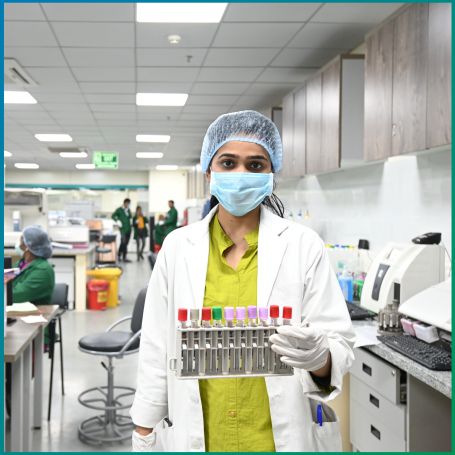
The C/S Exposure Plate Test (Culture and Sensitivity) is a microbiological test used to assess the contamination levels of various surfaces or air in a given environment.


The C/S Exposure Plate Test is a crucial diagnostic tool used to monitor the presence of microbial contamination in a variety of environments. It is commonly used in healthcare settings, laboratories, food production facilities, and other industries where maintaining a sterile or contamination-free environment is essential. This test involves exposing a culture plate to the environment or surface being tested, allowing microorganisms present in the air or on surfaces to settle onto the plate. The plate is then incubated in a controlled environment, and the resulting microbial growth is analyzed to determine the presence and types of microorganisms, such as bacteria, fungi, or molds.
1] Monitoring Sterility in Critical Environments - In healthcare settings, especially in surgical theaters or intensive care units (ICUs), maintaining a sterile environment is essential to prevent infections. The C/S Exposure Plate Test helps monitor airborne and surface contamination in these high-risk areas. It also plays a crucial role in identifying potential sources of infection in patient care areas or sterile zones, allowing for corrective measures to be taken before an infection can spread.
2] Identifying Pathogens - The test is designed to identify a wide variety of microorganisms, including bacteria, fungi, and molds. Common pathogens that may be detected include Staphylococcus aureus, Escherichia coli, Candida albicans, and Aspergillus species. Identification of these pathogens is critical for controlling outbreaks, especially in hospital settings, where patients may have weakened immune systems and are at higher risk for infections.
3] Ensuring Quality in Food and Pharmaceutical Industries - In the food and pharmaceutical industries, contamination can lead to compromised product quality or even product recalls. By using the C/S Exposure Plate Test, manufacturers can regularly monitor production areas, storage rooms, and packaging environments to ensure that no harmful microorganisms are present. This helps in maintaining product safety and adhering to stringent health regulations and standards.
4] Preventing Cross-Contamination - Regular testing with the C/S Exposure Plate Test helps prevent cross-contamination in settings where sterile conditions are critical. It ensures that surfaces, equipment, and the air in a facility remain free from harmful bacteria, fungi, or molds that could compromise the safety and sterility of products or medical procedures.
5] Compliance with Regulations - In many industries, such as healthcare and food manufacturing, strict guidelines and regulations require regular microbial testing to ensure safety and sterility. The C/S Exposure Plate Test helps companies meet these regulatory requirements, avoid penalties, and maintain accreditation from health and safety bodies.
1] Plate Exposure - The test begins with placing an agar plate in a specific location where contamination is suspected. This could be on a surface, in the air, or near equipment. The plate is typically exposed for a set period of time, often ranging from a few minutes to several hours, depending on the specific needs of the environment being tested.
2] Incubation - After exposure, the agar plate is carefully collected and incubated in a controlled environment at the appropriate temperature (usually 37°C for most pathogens) for a designated period (typically 24-48 hours). This allows any microorganisms that settled on the plate to grow into visible colonies.
3] Colony Counting and Identification - After the incubation period, microbiologists analyze the growth on the plate. Each colony represents a microorganism that settled on the plate. The colonies are examined for their size, shape, color, and other characteristics, which help in identifying the type of microorganism. In some cases, advanced techniques such as DNA sequencing or mass spectrometry may be used to identify the pathogens more quickly and accurately.
4] Sensitivity Testing - Once the microorganisms have been identified, sensitivity testing is performed to determine which antimicrobial agents (antibiotics, antifungals, etc.) are most effective at inhibiting their growth. This helps in selecting the best treatment for any infections and also aids in determining the effectiveness of disinfectants or antimicrobial agents used in the environment.
5] Result Interpretation - Results are reported based on the types of microorganisms identified and their antibiotic resistance profiles. A high microbial count could indicate poor sanitation or inadequate sterilization in an area. Depending on the results, corrective measures such as enhanced cleaning protocols, sterilization procedures, or the use of specific antimicrobial treatments may be recommended.
Choosing Diagnopein for the C/S Exposure Plate Test ensures accurate and reliable results for monitoring microbial contamination in critical environments. Diagnopein’s state-of-the-art laboratory facilities and advanced microbiological techniques provide precise pathogen identification and effective sensitivity testing. With a commitment to quality, their expert team ensures fast turnaround times, allowing for timely detection of harmful microorganisms in healthcare, pharmaceutical, and food production settings. Diagnopein’s focus on customer satisfaction, adherence to strict safety standards, and tailored solutions for contamination control make it the trusted partner for industries requiring the highest levels of sterility and safety. By selecting Diagnopein, you can confidently safeguard your environment against contamination and ensure compliance with regulatory requirements.
Yes, it helps monitor infection risks in sterile environments like operating rooms, ICUs, and patient rooms, ensuring that surfaces and air are free from harmful pathogens.
The test can detect bacteria, fungi, molds, and other pathogens such as Staphylococcus aureus, E. coli, Aspergillus, and Candida species.
Yes, it is widely used in food production and packaging areas to check for microbial contamination and ensure product safety.
It is used to monitor contamination levels in critical environments such as healthcare facilities, food production areas, and laboratories to ensure sterility and prevent infections or product contamination.